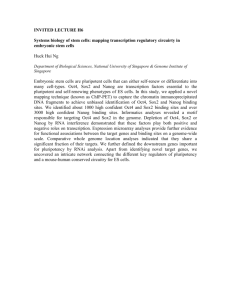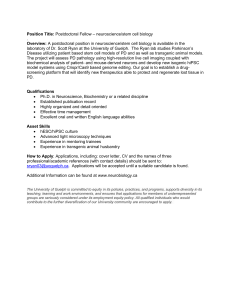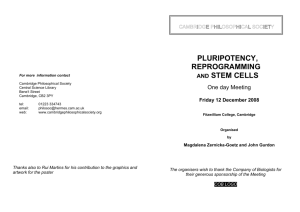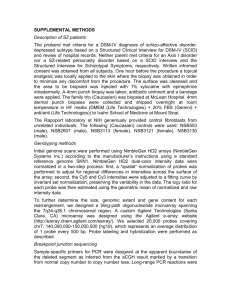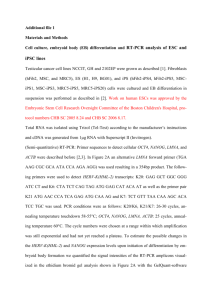Supplementary information for: Drug evaluation in cardiomyocytes
advertisement
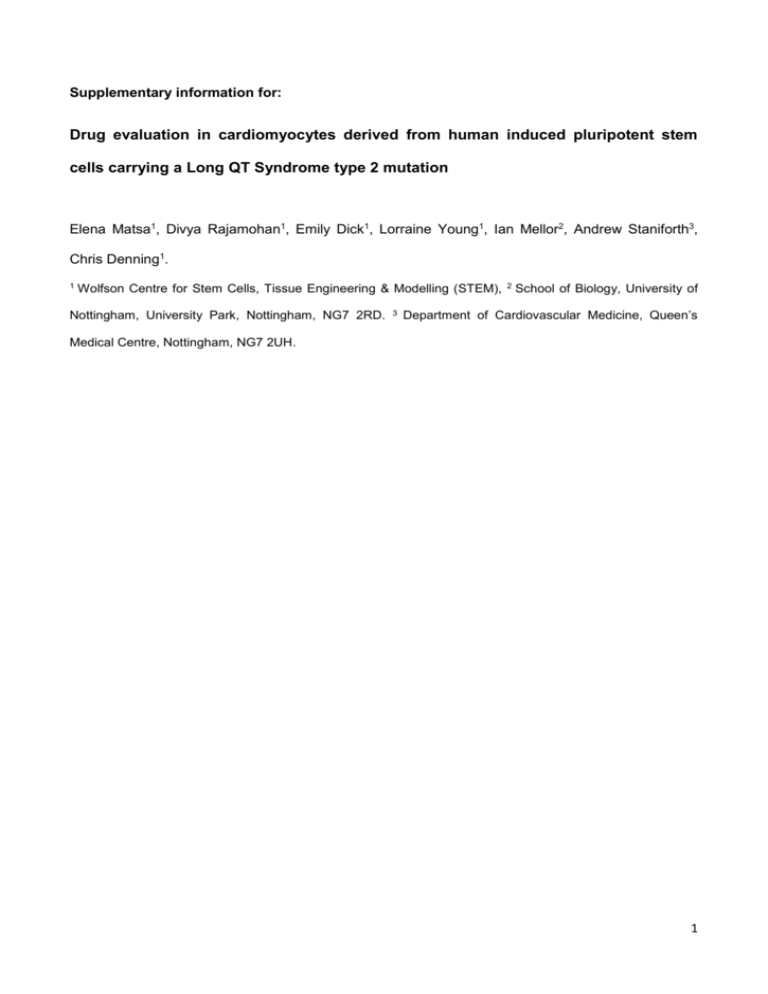
Supplementary information for: Drug evaluation in cardiomyocytes derived from human induced pluripotent stem cells carrying a Long QT Syndrome type 2 mutation Elena Matsa1, Divya Rajamohan1, Emily Dick1, Lorraine Young1, Ian Mellor2, Andrew Staniforth3, Chris Denning1. 1 Wolfson Centre for Stem Cells, Tissue Engineering & Modelling (STEM), Nottingham, University Park, Nottingham, NG7 2RD. 3 2 School of Biology, University of Department of Cardiovascular Medicine, Queen’s Medical Centre, Nottingham, NG7 2UH. 1 A B C Supplementary figure 1. Electrocardiogram traces for the LQT2 family. Full 12-lead electrocardiograms (ECGs) for A) the LQT2 female patient, as well as B) the patient’s mother and C) father. 2 A ii. iii. v. vi. vii. MAT HF i. B C Thr Cumulative PD Ala L E L E L MAT-hiPSC EBs E E E E 100bp ladder L LQT2-hiPSC MAT-hiPSC 5 10 15 20 Days in Culture MAT-hiPSC iPS L HF-iPSC L hESC G HF-hiPSC A G A LQT2 G PCR - MAT-hiPSC A G A G A LIN28 SOX2 NANOG OCT4 E MAT-Fib HF HF-iPSC D hESCs 0 MAT-hiPSC HF-ihPSC EBs HF-iPSC 20 18 16 14 12 10 8 6 4 2 0 Supplementary figure 2. Characterisation of control pluripotent stem cells. A) Monolayer cultures of hESC-derived fibroblasts (HF; Ai) and MAT-Fib (Aiv). hiPSC colonies generated from HF (Aii) and MAT-Fib (Av) following lentiviral transduction with human OCT4, NANOG, SOX2 and LIN28. Monolayer cultures of HF-hiPSCs (Aiii) and MAT-hiPSCs (Avi) at passage 15, grown in feeder-free conditions on Matrigel. Scale bars represent 100µm. B) Genomic sequencing in HFhiPSCs and MAT-hiPSCs confirming absence and presence of the KCNH2 G1681A mutation, respectively. C) Growth kinetics curves for monolayer cultures of hESCs, HF-hiPSC, MAT-hiPSC and LQT2-hiPSC lines. D) RT-PCR analysis of OCT4, NANOG, SOX2 and LIN28 expression from the endogenous (E) and lentiviral (L) loci in HF and MAT fibroblasts, hiPSCs and EBs. E) RT-PCR analysis in EBs derived from hESCs, HF-hiPSCs, MAT-hiPSCs and LQT2-hiPSCs, showing that the MAT and LQT2 samples express both the wild-type (G) and mutant (A; red arrows) KCNH2 1681 alleles. 3 KLF4 cMYC REX1 DNMT3B LIN28 SOX2 NANOG OCT4 P4HB A. Cy3 DAPI MERGE B. Cy3 DAPI MERGE 4 Supplementary figure 3. Expression of fibroblast and pluripotency markers. Immunofluorescence staining shows LQT2-Fib express the fibroblast-specific marker P4HB (A), while (B) shows LQT2-hiPSCs express the pluripotency markers OCT4, NANOG, SOX2, LIN28, DNMT3B and REX1. Both cell types express c-MYC and KLF4. Scale bars represent 65µm. The same profile was seen for HF and MAT fibroblasts and hiPSCs (data not shown). 5 Supplementary Table 1. Antibodies used for immunofluorescence staining and flow cytometry Primary antibody Supplier OCT4 SSEA4 SSEA1 TRA-1-81 P4HB c-MYC α-actinin β-III-tubulin AFP LIN28 REX1 Troponin-I SOX2 NANOG DNMT3B KLF4 Santa Cruz; SC-5279 Millipore; MAB4304 Millipore; MAB117P Millipore; MAB4381 Abcam; ab44971 Abcam; ab32 SIGMA; A7811 COVANCE; MMS-435P Sigma; A8452 Abcam; ab462020 Abcam; ab50828 Spectral Diagnostics; PA-1010 R&D Systems; AF2018 R&D Systems; AF1997 Santa Cruz; SC-10236 R&D Systems; AF3640 Dilution 1:200 1:50 1:50 1:50 1:50 1:250 1:800 1:1000 1:1000 1:1500 1:50 1:1000 1:200 1:50 1:250 1:100 Secondary antibody Supplier Dilution goat anti-mouse AlexaFluor® 633 Invitrogen; A21052 1:400 goat anti-rabbit AlexaFluor® 633 Invitrogen; A21071 rabbit anti-goat AlexaFluor® 568 Invitrogen; A11079 1:400 1:200 1:400 1:200 6 Supplementary Methods PATIENT CONSENT All subjects gave informed consent for blood testing for genetic abnormalities associated with hereditary LQTS. Isolation and use of patient fibroblasts was approved by the Nottingham Research Ethics Committee (License 09/H0408/74), and sample collections are registered with the UK Clinical Research Network under project 8164; “Modelling Long QT Syndrome”. CULTURE OF PATIENT-SPECIFIC FIBROBLASTS Dermal fibroblasts from the LQT2 patient and her mother were prepared from 4mm skin punch biopsies, after informed consent was given by the patients. Skin samples were cleaned from adipose and epidermal tissue and were minced to 1mm pieces. They were then digested with 2.5% trypsin (Invitrogen) for 15min, and 1mg/ml Collegenase IV (Invitrogen) for 90min, both at 37 oC. Digested cells were plated in Chang’s-D medium (Metachem) supplemented with 2mM L-glutamine (Invitrogen) and 100mM HEPES (SIGMA), and were grown for 2-3 weeks until fibroblast populations emerged. Fibroblasts were grown in DMEM medium (Invitrogen), supplemented with 10% FBS, 0.1mM non-essential amino acids (Invitrogen) and 2mM L-glutamine. GENERATION OF PATIENT-SPECIFIC hiPSCS Fibroblast cells were seeded onto tissue culture-treated 6 well plates (NUNC) at a density of 100,000 cells/well and left to adhere to the plastic for 4h. Cells were infected with lentiviral particles, prepared as described in [1]. Briefly, lentiviral particles encoding human OCT4, SOX2, LIN28 and NANOG [2] were produced using the HEK293T cell line, BL15, modified to express a biotin acceptor peptide domain on its cell surface [3, 4]. Viral supernatants were precipitated via incubation in 60mM CaCl2 at 37 °C for 30-40min and then purified by conjugation to streptavidin paramagnetic beads (Promega), for 3-5h at room temperature on a rolling platform. Viral particles were finally resuspended in DMEM with 10% FBS, and were used to transduce fibroblasts at an MOI of 5 for each virus. A medium change with fibroblast culture medium was performed 24h post transduction 7 (PTD), and 48h PTD the cells were transferred to 90mm dishes where they were cultured onto mitomycin C inactivated MEFs (3.6x106 cells/plate) in hiPSC culture medium (DMEM-F12 supplemented with 15% KSR, 100µM β-mercaptoethanol, 10ng/ml bFGF (Sigma-Aldrich), 2mM GlutaMAX™-1 (Invitrogen), and 0.1mM non-essential amino acids). The medium was changed daily with hiPSC culture medium for 1 week, and with MEF conditioned medium [5] supplemented with 10 ng/ml bFGF thereafter. At 18-23 days PTD, reprogrammed hiPSCs were isolated by TRA-1-81 based positive selection over a magnetic column (Miltenyi Biotec), as described previously [1]. hiPSCs were then transferred to feeder-free conditions on Matrigel-coated flasks, as described previously [6] and cultured in MEF conditioned medium supplemented with 10ng/ml bFGF. Two independent hiPSC lines were derived from each type of fibroblast sample. GROWTH AND MAINTENANCE OF hESCS The hESC line HUES7 was maintained under feeder-free conditions on Matrigel-coated flasks, and cultured in MEF conditioned medium supplemented with 4ng/ml bFGF, as previously described [6]. DETERMINATION OF POPULATION DOUBLING TIME Population doublings (PDs) at each passage were calculated using the formula [log10 (total cell counts/cells seeded)/ log10 (2)], where the cell number seeded was 1.2x106 cells/t25 flask. Proliferation rates were calculated by total hours in test culture/ cumulative PDs. DETERMINATION OF KARYOTYPE STABILITY Metaphase spreads were prepared as previously described [5, 7] from hiPSCs at passage 15, and karyotype analysis was performed by G-banding of 30 metaphase spreads in each sample, according to guidelines from the International System for Human Cytogenetic Nomenclature (ISCN, 2005). DETECTION OF PLURIPOTENCY MARKER EXPRESSION 8 For flow cytometry analysis, cells were harvested and fixed in 4% paraformaldehyde (PFA, Sigma-Aldrich), then resuspended in 2% FBS in PBS. Cells were incubated in the dark with PEconjugated antibodies, or relevant isotype controls, for 20min at room temperature, washed in 2% FBS and analysed in a flow cytometer (FC500, BD Biociences). For immunofluorescence, cells were grown to confluence in 8-chamber glass slides (NUNC) and then fixed in 4% PFA. Cells were permeabilised with 0.1% Triton-X-100 (Sigma-Aldrich), and blocked with 8% goat or rabbit serum (Sigma-Aldrich) in PBS, as appropriate. Primary antibody incubations were performed overnight at 4°C and secondary antibodies at room temperature for 1h (antibody dilutions shown in supplementary table 1). Cells were imaged using a Nikon Eclipse 90i fluorescence microscope and images were analysed using Volovity software (Improvision). BISULPHITE SEQUENCING OF GENOMIC DNA Cell pellets from fibroblasts (passage 6), reprogrammed hiPSC lines (passage 15-17) and their differentiated progeny (day 25) were analysed to determine the methylation status of key regulatory regions in the endogenous OCT4 and NANOG promoters. Genomic DNA was extracted from frozen cell pellets (QIAGEN DNeasy Blood and Tissue kit) and bisulfite conversion of genomic DNA, PCR and DNA methylation analysis were performed as described previously [1]. ENDOGENOUS AND LENTIVIRAL EXPRESSION OF OCT4, NANOG, SOX2 AND LIN28 Reactivation of endogenous OCT4, NANOG, SOX2 and LIN28, and silencing of lentiviral transgenes in hiPSC lines and their differentiated progeny was performed by RT-PCR, as described previously [1]. IN VITRO DIFFERENTIATION TO THE THREE EMBRYONIC GERM LAYERS To determine whether hiPSC lines could generate derivatives of the three embryonic germ layers in vitro, cells were differentiated via embryoid body (EB) formation as described above. On day 25 of differentiation, EBs were seeded onto 16-chamber glass slides and fixed on day 30, in 4% 9 PFA. Analysis for the expression of proteins representing the three germ layers; β-III-tubulin for ectoderm, α-fetoprotein for endoderm, and α-actinin or troponin-I for mesoderm, was performed by immunofluorescence staining as described above (antibody dilutions in Supplementary Table 1). IN VITRO DIFFERENTIATION TO CARDIAC MYOCYTES hiPSC lines were differentiated via embryoid body (EB) formation, using forced aggregation of defined numbers of cells, as described previously [8]. Briefly, on day 0 of differentiation, EB formation was initiated by seeding V-96 plates with 3,000 or 6,000 cells/well in MEF conditioned medium and centrifuging at 950g for 5min, at room temperature. EBs were maintained in V-96 plates for 4 days in conditioned medium, and were then transferred to untreated 90mm dishes in DFBS (DMEM supplemented with 20% Foetal Bovine Serum, 100mM b-ME, 1% NEAA, and 2mM GlutaMAX). EBs were maintained in suspension for 6 days to allow further differentiation and then transferred to untreated U-96 well plates at a density of one EB/well, in D-FBS. Spontaneously beating clusters were observed from day 11 of differentiation onwards. Between days 25-30, beating clusters were either mounted onto multi-electrode arrays (MEAs) for electrophysiology analysis or were dissociated into single cells for patch clamp analysis. ELECTROPHYSIOLOGICAL ANALYSIS For the measurement of extracellular field potentials by MEA analysis, beating clusters were plated directly onto Matrigel-coated MEAs (Scientifica) as described previously [9]. Recordings were performed at 37oC in Normal Tyrode’s Buffer (140mM NaCl, 10mM Glucose, 10mM HEPES, 4mM KCl, 1mM MgCl2, 1.8mM CaCl2 pH 7.45) using 2 kHz sampling rate. Data were captured and processed using MC_Rack and MC_DataTool software (Multi Channel Systems). For whole-cell patch recordings of action potentials, beating clusters were disaggregated as described previously [10, 11]. Briefly, beating areas were manually dissected, washed in PBS, and then incubated for 30min at room temperature in buffer 1 (120mM NaCl, 5.4mM KCl, 5mM MgSO 4 , 5mM sodium pyruvate, 20mM taurine, 10mM HEPES, 20mM glucose, pH 6.9), for 45min at 37°C in buffer 2 (120mM NaCl, 5.4mM KCl, 5mM MgSO, 5mM sodium pyruvate, 20mM taurine, 10mM 10 HEPES, 0.3mM CaCl2, 20mM glucose, 1mg/ml collagenase B, pH 6.9) and for 1 hour at room temperature in buffer 3 (85mM KCl, 5mM MgSO4, 5mM sodium pyruvate, 20mM taurine, 1mM EGTA, 5mM creatine, 30mM K2HPO4, 20mM glucose, 1mg/ml Na2ATP, pH 7.2). Finally, cell clusters were dissociated by repeated pipetting through a P1000 tip, and the liberated cells were seeded onto 35mm dishes with a glass coverslip (MatTek). Whole-cell patch-clamp recordings of spontaneously beating single cells were obtained using an Axopatch 200A patch-clamp amplifier (Axon Instruments/Molecular Devices) in normal current-clamp mode [12]. Cells were maintained at 37oC, in Normal Tyrode’s Buffer during recordings and pipettes, pulled on a Sutter P-97 programmable micropipette puller, had resistances of 5–10 M when filled with ionic solution (145mM KCl, 5mM NaCl, 2mM CaCl2, 2mM MgCl2, 4mM ethylene glycol tetra-acetic acid, 10mM HEPES, pH 7.3). Data were transferred to a PC via an A/D interface (Model PCI-6014, National Instruments) and were recorded and analyzed using WinEDR v3.1.4 software (Strathclyde Electrophysiology Software). Supplementary References: 1. Dick E, Matsa E, Bispham J, Reza M, Guglieri M, Staniforth A, Watson S, Kumari R, Lochmuller H, Young L, Darling D, Denning C. Two new protocols to enhance the production and isolation of human induced pluripotent stem cell lines. Stem Cell Res 2011;advance online publication. 2. Yu J, Vodyanik MA, Smuga-Otto K, Antosiewicz-Bourget J, Frane JL, Tian S, Nie J, Jonsdottir GA, Ruotti V, Stewart R, Slukvin, II, Thomson JA. Induced pluripotent stem cell lines derived from human somatic cells. Science 2007;318:1917-1920. 3. Nesbeth D, Williams SL, Chan L, Brain T, Slater NK, Farzaneh F, Darling D. Metabolic biotinylation of lentiviral pseudotypes for scalable paramagnetic microparticle-dependent manipulation. Mol Ther 2006;13:814-822. 4. Chan L, Nesbeth D, Mackey T, Galea-Lauri J, Gaken J, Martin F, Collins M, Mufti G, Farzaneh F, Darling D. Conjugation of lentivirus to paramagnetic particles via nonviral proteins allows efficient concentration and infection of primary acute myeloid leukemia cells. J Virol 2005;79:13190-13194. 5. Braam SR, Denning C, van den Brink S, Kats P, Hochstenbach R, Passier R, Mummery CL. Improved genetic manipulation of human embryonic stem cells. Nat Methods 2008;5:389-392. 6. Denning C, Allegrucci C, Priddle H, Barbadillo-Munoz MD, Anderson D, Self T, Smith NM, Parkin CT, Young LE. Common culture conditions for maintenance and cardiomyocyte differentiation of the human embryonic stem cell lines, BG01 and HUES-7. Int J Dev Biol 2006;50:27-37. 7. Thomas RJ, Anderson D, Chandra A, Smith NM, Young LE, Williams D, Denning C. Automated, scalable culture of human embryonic stem cells in feeder-free conditions. Biotechnology and Bioengineering 2009;102:1636-1644. 8. Burridge PW, Anderson D, Priddle H, Barbadillo Munoz MD, Chamberlain S, Allegrucci C, Young LE, Denning C. Improved human embryonic stem cell embryoid body homogeneity and cardiomyocyte 11 differentiation from a novel V-96 plate aggregation system highlights interline variability. Stem cells (Dayton, Ohio) 2007;25:929-938. 9. Mahlstedt MM, Anderson D, Sharp JS, McGilvray R, Barbadillo Munoz MD, Buttery LD, Alexander MR, Rose FR, Denning C. Maintenance of pluripotency in human embryonic stem cells cultured on a synthetic substrate in conditioned medium. Biotechnol Bioeng 2010;105:130-140. 10. Maltsev VA, Wobus AM, Rohwedel J, Bader M, Hescheler J. Cardiomyocytes differentiated in vitro from embryonic stem cells developmentally express cardiac-specific genes and ionic currents. Circ Res 1994;75:233-244. 11. Moore JC, van Laake LW, Braam SR, Xue T, Tsang SY, Ward D, Passier R, Tertoolen LL, Li RA, Mummery CL. Human embryonic stem cells: genetic manipulation on the way to cardiac cell therapies. Reprod Toxicol 2005;20:377-391. 12. Anderson D, Self T, Mellor IR, Goh G, Hill SJ, Denning C. Transgenic Enrichment of Cardiomyocytes From Human Embryonic Stem Cells. Mol Ther 2007;15:2027-2036. 12
